Standards Worldwide
Standards Worldwide
Phone +49 30 58885700-07

Standard [CURRENT]
ASTM D 5909:2020
Standard Test Method for Drying Time of Oxidative-Drying Printing Inks by Squalene Resistance
- Publication date
- 2020
- Original language
- English
- Pages
- 3
- Note
- The publisher recommends this document in lieu of the withdrawn document ASTM D 5909a:1996 , for which no replacement is available.
- Publication date
- 2020
- Original language
- English
- Pages
- 3
- Note
- The publisher recommends this document in lieu of the withdrawn document ASTM D 5909a:1996 , for which no replacement is available.
- DOI
- https://dx.doi.org/10.1520/D5909-20
Product information on this site:
Quick delivery via download or delivery service
Buy securely with a credit card or pay upon receipt of invoice
All transactions are encrypted
Short description
1.1 This test method covers the procedure for determining the drying time of oxidative-drying printing inks (also referred to as "sheetfed inks") by squalene resistance of printed ink films. 1.2 This test method is applicable to all paste inks that dry primarily by oxidation regardless of the substrate on which they are printed. With appropriate changes in the test fluid, it may also be used with paste inks that dry by other mechanisms, such as heatset or ultraviolet light. 1.3 This test method utilizes a modified rub tester and is intended to serve as a "referee" procedure when laboratories, using less rigorous test procedures (see Appendix X1 ), cannot agree on their results. 1.4 The values stated in SI units are to be regarded as the standard. The values given in parentheses are for information only. 1.5 This standard does not purport to address all of the safety concerns, if any, associated with its use. It is the responsibility of the user of this standard to establish appropriate safety, health, and environmental practices and determine the applicability of regulatory limitations prior to use. 1.6 This international standard was developed in accordance with internationally recognized principles on standardization established in the Decision on Principles for the Development of International Standards, Guides and Recommendations issued by the World Trade Organization Technical Barriers to Trade (TBT) Committee.
ICS
87.080
DOI
https://dx.doi.org/10.1520/D5909-20
Loading recommended items...
Loading recommended items...
Loading recommended items...
Loading recommended items...
